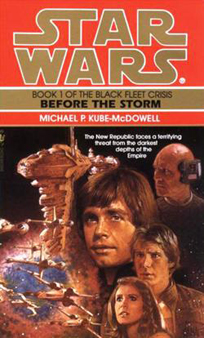Michael P. Kube-McDowell’s “Black Fleet Crisis” paperback trilogy, which starts with 1996’s “Before the Storm,” has so many common “Star Wars” elements that it blends in with other stories. There’s a missing fleet, which calls to mind the Katana Fleet from the Thrawn trilogy; there’s a previously unknown alien foe, which calls to mind “The Truce at Bakura” and the “New Jedi Order” series; Lando explores a weird alien structure, which is reminiscent of “Lando Calrissian and the Mindharp of Sharu”; and Luke investigates his family tree, an element from “Tatooine Ghost” and the “Dark Nest” trilogy.
All that having been said, “Before the Storm” is a very solid novel. Some readers probably lump it in with the dregs of the 1990s Bantam series, but I think it’s above average. Probably one of the criticisms is that Leia is incompetent at her job as president of the Senate and commander-in-chief of the New Republic’s armed forces. Admiral Ackbar, General A’baht, intelligence agent Drayson, and even Han all work behind Leia’s back at various points. But her flaw here is a noble one: She wants to believe that Yevethan ambassador Nil Spaar is a good guy. She gives him every benefit of the doubt as he constructs a web of lies to get Leia ousted from office and put the New Republic’s government in chaos as he starts a war with his secret Black Fleet of former Imperial ships.
In this book, McDowell has a very sunny view of people who hold governmental power in the New Republic, but he’s not naïve: He understands that the higher you go, the fewer checks and balances there are. An exchange between Leia and Drayson on page 299 outlines this:
Leia: “Who do you answer to?”
Drayson: “The same as you do, Princess – the same as anyone at our level does. I answer to my conscience and my sense of duty. And yes, if either of us fails, we can do a great deal of harm – and probably hide most of it, too. But that’s all there is, isn’t it? Conscience or obedience. Leader or follower. Whose orders do you obey?”
The Yevetha, for their part, are pretty great villains. They just wanted to be left alone, but the Empire enslaved them and colonized some of the worlds in the cluster of stars they claimed as their own. Now, obviously, there’s no excuse for the genocides that Spaar orders at the end of “Before the Storm,” but imagine that an alien race suddenly colonized Earth’s moon: Even if they totally left us alone, we as a human race would feel violated. The Yevetha’s murders aren’t justified, but their feelings are relatable, and that makes them better villains than the Ssi-ruuk or the Yuuzhan Vong.
Some readers probably would argue that Lando is out of character in “Before the Storm,” as instead of working on an entrepreneurial venture, he volunteers to investigate the Teljkon Vagabond, a mysterious ship floating in interstellar space that immediately calls to mind the Arthur C. Clarke novel “Rendezvous with Rama.” I find Lando’s personality here to be similar to L. Neil Smith’s trilogy, where Lando would bounce ideas off Vuffi Raa. Here, he shoots the breeze with Lobot, C-3PO and R2-D2.

I will grant that Luke’s characterization is … interesting … in the early chapters. Feeling bombarded by demands (I imagine Buffy in “Earshot,” where she can hear everyone’s thoughts), the Jedi Master leaves the academy reins to Streen and then finds a secret cave in the cold regions of Coruscant to become a hermit. I found this odd, because it seems that Yavin IV would be a great place to be a hermit; he could just assign his students a lesson plan on meditation or something. At any rate, Luke’s “leave me alone” arc is blown up when he’s visited by Akanah, a Fallanassi (a branch of Force-users) who claims Luke’s mom, “Nashira,” was once part of her tribe.
Post-prequels, one might assume that McDowell made the mistake of introducing Luke’s mom only to have it wiped out by George Lucas’ official stories. But recall that Bantam cleared its story points with Lucasfilm as part of the editing process. Of course, there were some “oopses,” including Boba Fett’s backstory being contradicted by “Episode II.” However, that’s not the case here. Akanah, as we find out in a cliffhanger, is playing Luke. She possesses the ability to cast allusions, and wins him to her side by projecting two Imperial agents attacking her. So Nashira was never intended to literally be Luke’s mom.
(By the way, the fact that historical documents on Anakin and – even more so – Padme are impossible for Luke to track down is perhaps the biggest “suspend your disbelief” element of the Expanded Universe. However, I’ll give McDowell a pass for two reasons: One, he was following the lead of other writers, and two, no one was allowed to give these answers to Luke and Leia until the prequels came out and we all finally got the answers. Finally, in 2005’s “Dark Nest” trilogy, a 40-something Luke and Leia would learn their mom’s identity.)
In one case, McDowell anticipates (or, arguably, introduces) an element from the prequels: R2-D2’s propulsion jets! From page 211:
The lack of handholds in the chamber was not the problem for the droid that it was for the general. Thanks to the array of small gas thrusters built into all astromech droids, Artoo’s motions were far more controlled than Lando’s.
I imagine West End Games introduced Artoo’s thrusters, but still, it’s cool to see them incorporated into a pre-1999 story. Of course, Artoo blasts around with his jets throughout the prequels and “The Clone Wars,” but it was a rarity in the 1990s stories. If there are other examples, I don’t know them off the top of my head.
Even when I thought McDowell was heading down an apocryphal path in “Before the Storm,” he pulls it back. Luke flies an E-wing at the start of the book, as per the military’s strong suggestion, but soon he reflects on how he’s planning to switch back to his trusty old X-wing and Artoo (who can’t fit in the droid socket of an E-wing).
While the triple mysteries of “Before the Storm” might be too slow-moving for some, count me as intrigued heading into the second book of the trilogy.

